Forget Employee Loyalty, Engage!
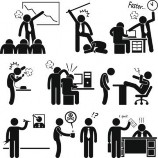 Every year companies lose billions of dollars due to employee turnover. When we realize most of it is actually voluntary, we have to wonder, what has happened to employee loyalty. Well, if you are using employee loyalty as a key measure in your organization, think again. Such a measure no longer offers the desired statistics to deal with today’s workforce dynamics.
Every year companies lose billions of dollars due to employee turnover. When we realize most of it is actually voluntary, we have to wonder, what has happened to employee loyalty. Well, if you are using employee loyalty as a key measure in your organization, think again. Such a measure no longer offers the desired statistics to deal with today’s workforce dynamics.
Please do not misunderstand me. I believe that employee loyalty is a great thing, and we should strive for it. However, I also believe that loyalty is earned rather than demanded, and to earn the loyalty of our employees we need, first and foremost, to engage them.
In case you haven’t noticed, things have changed quite a bit in the past two decades. Employees have become better informed, more connected, more social, more confident, and more expressive of their needs and wants. They have developed views toward many work and cultural values that differ from their parents’. This would include values like loyalty towards the workplace. Ask any university graduate today, and they will tell you their loyalty is toward their career; they want to work in a place that gives them the opportunity to grow, participate, and be satisfied with what they do. That shift in workplace loyalty means they will persevere in pursuing their dream job, even if it requires, for some of them, leaving their current employer, finding another job, or starting their own company!
 To make things more interesting, today’s employees are also quite aware they are the true asset of the 21st century organization. Everywhere we look innovation and creativity have become key drivers for the growth and success of companies, cities, states, provinces, emirates, and even countries. And employees today, regardless of the industry sector they work in, understand they are the main source of innovative and creative ideas, albeit small or minute, that fuel growth and provide a much needed competitive advantage in a very global and fierce world economy.
To make things more interesting, today’s employees are also quite aware they are the true asset of the 21st century organization. Everywhere we look innovation and creativity have become key drivers for the growth and success of companies, cities, states, provinces, emirates, and even countries. And employees today, regardless of the industry sector they work in, understand they are the main source of innovative and creative ideas, albeit small or minute, that fuel growth and provide a much needed competitive advantage in a very global and fierce world economy.
So let us not fret over employee loyalty which, after all, is an outcome. Let us focus instead on the actions that will lead us to that outcome, wouldn’t you agree? Let us talk about employee engagement: What is it? Why do we need it? Who should be driving it? How do we go about it? What should we measure and how do we measure it? And, finally, when do we start? Lots of questions I know; a key point to remember, employee engagement does not normally start with the employee, but rather with the employer.
What is employee engagement?
If I were to describe engaged employees, my description would go something like this:
In this article, I will discuss some causes and some solutions for stress at work and at home
Engaged employees,
- Know their job responsibilities very well, and how their productivity and contributions are measured. They are also not afraid to ask questions when they don’t understand certain aspects of their jobs.
- Perceive their job as important, and fully understand how their job impacts the company’s bottom line.
- Contribute to their job descriptions. They fully understand that certain aspects of their job are fun, while others are mundane or boring. However, they know quite well they are accountable to deliver both in a high quality fashion.
- Discuss solutions rather than complain about problems. They contribute new ideas to improve the workplace, business processes or even introduce new products or services. They know their opinions matter and that their ideas will be acknowledged, seriously considered and evaluated.
- Do not feel stuck in their job. On the contrary, they always discuss career options and possible growth opportunities driven by their performance and contributions.
- Seek opportunities to develop their knowledge and skills to enrich their job and enhance their productivity.
- Communicate in a transparent and respectful way with their colleagues, subordinates, superiors, and even senior managers, while stating their concerns without fear of repercussions.
- Seek opportunities to develop their knowledge and skills to enrich their job and enhance their productivity.
- Receive regular feedback on their performance and utilize the power of the conversation or coaching to establish a common understanding of performance issues and how to rectify or improve them.
You can probably add a couple of items to this description. You can also refer to the original article by Professor William Khan, where he defined employee engagement as: “The harnessing of organization members' selves to their work roles; in engagement, people employ and express themselves physically, cognitively, and emotionally during role performances.” The article was published in a 1990 Academy of Management Journal. What one needs to understand is that the behavior associated with engaged employees leads to the exceptional successes many companies so desperately desire and try to find. Which leads us to the next important point: why do we need it?
Why employee engagement?
 There is a direct correlation between the behavior of an engaged employee and the growth and cost savings companies achieve through that behavior. Yes, employee engagement works both ways: It helps companies grow while lowering costs; it is a precious concept which is often misunderstood and seldom exploited. In companies where employee engagement scores are low, the estimated cost of replacing an employee is between 90% and 200% of their annual salary (source SHRM). This excludes the impact that a departing employee would have on the morale of other employees, the actual drop in productivity that results from an employee departing until a new one is identified, hired, trained and ready to take on the new job. Low employee engagement scores are also leading indicators for low employee retention, low employee morale, low job satisfaction, dysfunctional and poorly maintained processes, low customer satisfaction, high number of customer complaints, high absenteeism, and more. All of this result in an unhealthy, firefighting environment - door-revolving culture, which eventually translates into more dissatisfied customers, less profit, more irate stakeholders and even more disengaged employees; when companies enter such a vicious circle the outcomes are easy to predict.
There is a direct correlation between the behavior of an engaged employee and the growth and cost savings companies achieve through that behavior. Yes, employee engagement works both ways: It helps companies grow while lowering costs; it is a precious concept which is often misunderstood and seldom exploited. In companies where employee engagement scores are low, the estimated cost of replacing an employee is between 90% and 200% of their annual salary (source SHRM). This excludes the impact that a departing employee would have on the morale of other employees, the actual drop in productivity that results from an employee departing until a new one is identified, hired, trained and ready to take on the new job. Low employee engagement scores are also leading indicators for low employee retention, low employee morale, low job satisfaction, dysfunctional and poorly maintained processes, low customer satisfaction, high number of customer complaints, high absenteeism, and more. All of this result in an unhealthy, firefighting environment - door-revolving culture, which eventually translates into more dissatisfied customers, less profit, more irate stakeholders and even more disengaged employees; when companies enter such a vicious circle the outcomes are easy to predict.
 When a company enjoys high employee engagement scores the opposite happens. When employees are engaged their productivity goes up by 47% (source Hay Group). High employee engagement scores are leading indicators for high employee retention, high employee morale, high job satisfaction, innovative and efficient processes, high customer satisfaction, low absenteeism and sick leave. This, results in a healthy, proactive employee and organizational culture, which eventually translates into higher customer satisfaction, higher profit and happier investors.
When a company enjoys high employee engagement scores the opposite happens. When employees are engaged their productivity goes up by 47% (source Hay Group). High employee engagement scores are leading indicators for high employee retention, high employee morale, high job satisfaction, innovative and efficient processes, high customer satisfaction, low absenteeism and sick leave. This, results in a healthy, proactive employee and organizational culture, which eventually translates into higher customer satisfaction, higher profit and happier investors.
Consider the following: Companies that increase the number of managers who know how to keep employees engaged achieve, on average, 147% higher earnings than their competition (source Gallup). This begs the question: Who is responsible for employee engagement?
Who should be driving employee engagement?
Employee engagement is everyone’s responsibility, and that includes the employees. It may not start with them, but it does not mean they are absolved. Employee engagement is a reciprocal equation, and when employees see management trying to reach out and engage, generally they will engage, especially when intentions are good and expectations are clearly set. Incidentally, have you ever wondered who gets the concept of employee engagement better: management or employees? My bet is on the employees. In fact they have been asking for it all along. Sadly, traditional management thinking, conservative management views of employees and management insecurities have been, and still are, major obstacles toward proper engagement. This takes us to the central figure with the biggest role in all of this: the manager.
Managers - and people managers in particular – are, more than anyone else, the ones who can initiate and drive employee engagement and on whom most of its success or failure rests. You cannot expect leaders (i.e. CXOs, VPs, etc.) to fully engage. Those who do cannot do it full time as they have to captain the ship and guide it. Managers, on the other hand, have that responsibility, opportunity and privilege because they are closer to the action. Unfortunately, managers who engage well are scarce, and some serious effort is required to equip, train, coach and mentor a new class of managers who understand the importance of employee engagement, and are willing to apply it as second nature, as a habit and as part of their normal responsibilities. I know it is not an easy task, but how about that “147% higher earnings than competition” that engaged organizations enjoy? Isn’t that enough justification to start changing things around? Or how about the US $ 300 Billion cost associated with employee disengagement that affected organizations incur every year? Isn’t this a great incentive to sit around the table and discuss an employee engagement strategy?
Of course it is! As a matter of fact many managers are willing to engage. But in the majority of cases they curb their enthusiasm when they encounter the huge cultural wall built over the years, and safeguarded by the same leadership that talks employee engagement but relents when it comes to taking a full leap forward; these are the organizations that need employee engagement the most.
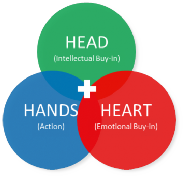 While we need managers to drive employee engagement, we cannot hold them fully responsible for its success. Leadership has to be held accountable when it comes to the support, funding and training they assert they will provide. Managers will execute, but leaders have to support (heart, mind. and action). Hence, I propose that employee engagement becomes a score on every leader’s scorecard, and I am dead serious about it. Look at Mr. Jerome Dodson, President of and Portfolio Manager at Parnassus Investments. Mr. Dodson’s investment strategy is to invest in companies that treat people well. Very interesting! This investment strategy has allowed his portfolio to consistently outperform the majority of other funds by an additional 4%. The logic is easy: Engaged organizations make more profits and cut cost.
While we need managers to drive employee engagement, we cannot hold them fully responsible for its success. Leadership has to be held accountable when it comes to the support, funding and training they assert they will provide. Managers will execute, but leaders have to support (heart, mind. and action). Hence, I propose that employee engagement becomes a score on every leader’s scorecard, and I am dead serious about it. Look at Mr. Jerome Dodson, President of and Portfolio Manager at Parnassus Investments. Mr. Dodson’s investment strategy is to invest in companies that treat people well. Very interesting! This investment strategy has allowed his portfolio to consistently outperform the majority of other funds by an additional 4%. The logic is easy: Engaged organizations make more profits and cut cost.
Here is another nice story about SAS, a leader in business analytics which has been on Fortune’s list of the “100 Best Companies to Work For” since the list started in 1998. In 2015 they ranked number Four (4). CEO Jim Goodnight’s philosophy in running SAS is to build a company where employees will “clamor” to work for and don’t want to leave.
In his article “How SAS Became the World’s Best Place to Work”, Mark C. Crowley has this to say about Dr. Jim Goodnight: “At 70 years old, Goodnight holds the conviction that what makes his organization work are the new ideas that come out of his employee’s brains. He therefore holds his employees in the highest esteem. So while he fully anticipated that the recession would constrain the firm’s short-term revenues, he instinctively knew that his team would produce breakthrough products while his competitors were cutting costs.” Engagement, reciprocation and loyalty are the natural outcomes of Goodnight’s philosophy. SAS earned the loyalty of its employees because leadership and management engaged them the right way.
So, once leadership is committed to employee engagement, what skills or talents do managers need to get their employees better engaged with their workplace environment, and translate organizational visions, culture, and strategies more effectively? How can they take better advantage of the cause and effect relationship between employee engagement and outstanding results? According to Randall Beck and James Harter in their “Why Good Managers Are so Rare” (HBR – March 13 2014), managers who are great at employee engagement have the following talents:
- They motivate every single employee to take action and engage them with a compelling mission and vision.
- They have the assertiveness to drive outcomes and the ability to overcome adversity and resistance.
- They create a culture of clear accountability.
- They build relationships based on full transparency that create trust and open dialogue.
- They make decisions that are based on productivity, not politics.
I would like to add another four key talents that I deem vital for every engaging manager:
- The first one is coaching, which contributes to the creation of a successful, positive and healthy employee engagement scene.
- The second one is one of my favorites: Listening.
- The third one is talent management, and
- The fourth one is the ability to lighten up a bit.
In Table 1 below I show how these talents link to the behavior of an engaged employee. All these talents
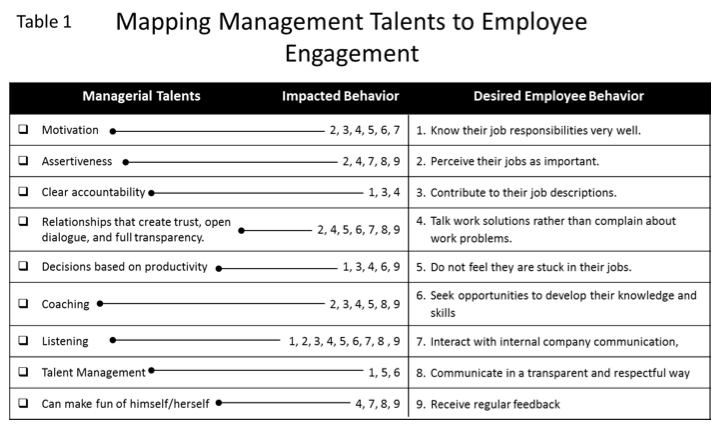
need to be stressed and measured regularly at all managerial levels to generate the desired behavior.
The role of leadership and senior management is to build and accelerate the development of such talents, and expand this scarce pool of outstanding managers from a ratio of 1 in 10 to 3 or 4 in 10. We will always have average and sub-par managers, but every small gain generates exponentially bigger positive outcomes. The intention is to tip the scale slightly in favour of best managerial practices to deliver outstanding results.
How should managers go about achieving employee engagement?
No two organizations are the same. Each organization has to develop its employee engagement initiatives based on its own reality. The approach to determine these initiatives consists of defining what is important to employees on the one hand and what is critical to management on the other. Once defined, the organization should first focus on the points both sides consider important and develop the appropriate action plans. Starting with these points of common interest will encourage collaborative efforts and create vital quick wins which will help accelerate the development of a trustworthy relationship. Where points of difference exist, both parties can meet, discuss, and find ways to bridge gaps while building upon the small wins they achieved together.
Figure 1 below illustrates the idea just described. In this Alignment of Expectations Matrix, the X axis is concerned with the points that are important to the organization’s leadership and management, and the Y axis is concerned with those of the employees.
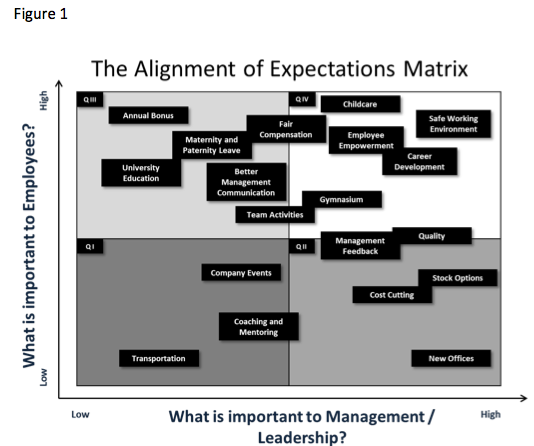 The matrix is a very simple tool that can make quite a difference when establishing or creating an engaging atmosphere in the workplace.
The matrix is a very simple tool that can make quite a difference when establishing or creating an engaging atmosphere in the workplace.
The premise behind using this tool is trust and goodwill; otherwise, it will lead to wrong outcomes, and cause further disengagement and frustration.
Both management and employees have to enrich what they have in quadrant IV (Q IV) of figure 1, and whenever they run out of initiatives, they need to ensure they refill Q IV with new ones that both parties support, or they should meet to discuss ways to bridge the gaps with respect to some of the other ideas in other quadrants.
It is important that every initiative agreed upon be supported by a clear action plan that highlights milestones, ownership and critical success factors (CSF). This leads us to the question of how to measure the success of employee engagement.
What should we measure, and how do we measure it?
The behaviors mentioned above in my description of engaged employee are a perfect place to start. Each of these behaviors has to be linked to a statement which ensures that when the feedback is received it can be measured, reviewed and acted upon. Table 2 below, illustrates the type of statements one could use to gauge the required behavior.
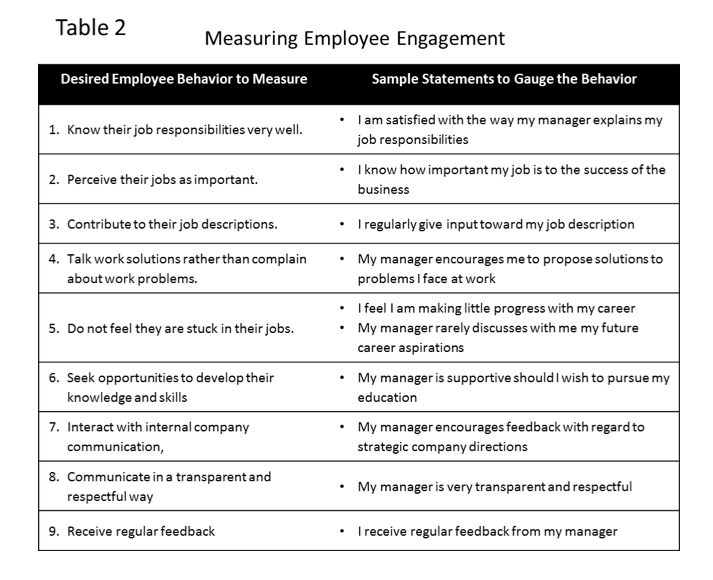
These statements are normally included as part of a survey Human Resources, in coordination with other departments, publishes via e-mail, internal website, or through an external website such as SuveyMonkey.com to which employees are directed. Employees normally have to make a selection based on a Likert or Numerical Rating Scale.
The most commonly used Likert scale format is a five point scale ranging from 'strongly disagree' to 'strongly agree' as shown in Figure 2:
 Once employees submit the surveys, the scoring is done, and the results are analyzed. For example, one of the areas that could be measured is the percentage of respondents who are satisfied with the way managers explain their employees’ job responsibilities. If the percentages are too low, actions can be taken to rectify some of the mistakes managers may be making, or seek employees’ opinion on what can be done better.
Once employees submit the surveys, the scoring is done, and the results are analyzed. For example, one of the areas that could be measured is the percentage of respondents who are satisfied with the way managers explain their employees’ job responsibilities. If the percentages are too low, actions can be taken to rectify some of the mistakes managers may be making, or seek employees’ opinion on what can be done better.
The Numerical Rating Scale works in a similar fashion, however, participants in the survey normally need to select a number between 1 and 10, with 10 being best.
In addition to the above approach, Gallup has what is known as the Q12 engagement measure, which uses criteria based on 12 points.
Other companies also use social media in a novel and quite informative way. According to J Schwan, Founder and CEO of Solistice Mobile, his company concentrates on two KPIs:
- Employee Net Promoter Score, similar to the Customer NP but used as the internal metric for employee engagement.
- Glassdoor (www.glassdoor.com), which is where many employees share their opinions about their companies, and which, according to Schwan, is the external metric for employee engagement.
For J Schwan and other similar companies, these 2 KPIs deliver the desired feedback they need to gauge employee engagement.
So, when should you start measuring employee engagement?
I encourage every company leader, director and manager to assess the situation they are in, and identify possible barriers to employee engagement. There are no easy answers here. An open mind, a serious and honest commitment to change, and some great listening skills should help overcome some of the tough feedback and challenges they might encounter. A simple survey is a great first step on the journey toward an engaged organization. If leaders happen to be running a great company, then I caution them against complacency, and remind them to keep asking and engaging their most valuable asset, their employees.
So, what are we waiting for? Let’s start engaging!
Jamal A. Said is a Senior Consultant for Meirc Training & Consulting. He is a subject matter expert on leadership, management, change management, sales, operations, strategy and business planning.
Related Articles

A Workplace Counseling Tale
In the heart of Dubai, nestled amidst towering skyscrapers and the hum…

Building a Culture of Continuous Learning
During times of turmoil and when it comes to reduced corporate spending,…

People Analytics: Transforming Organizations Through Power of Data
Data is crucial in shaping business strategies and decision-making processes…

The Impact of AI on the Corporate Training Industry
Having been at the forefront of corporate training for two decades, I…
